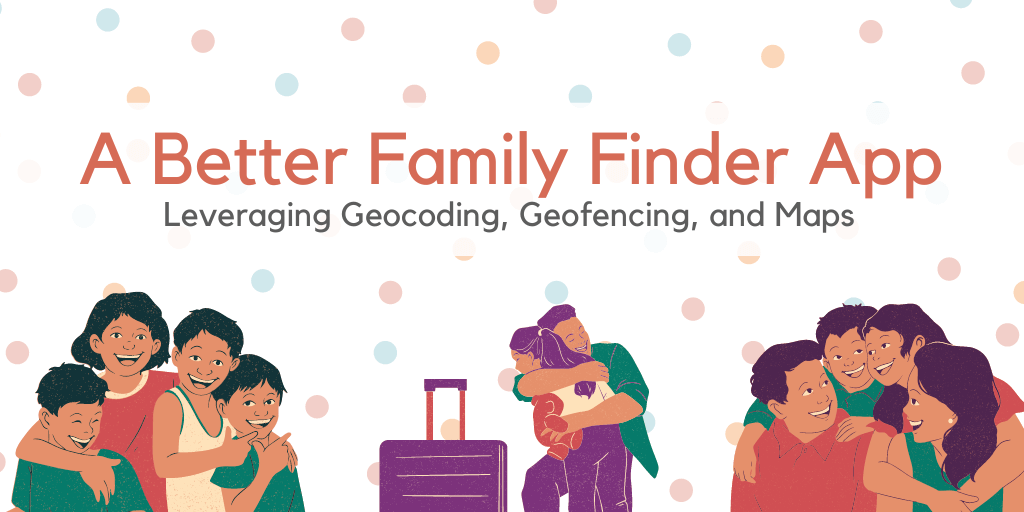As a business with a consumer app in the family/friend finder space, you already understand that location APIs are essential for providing your users with the best experience. This space has seen a significant increase in competition over the past few years, with many new apps entering the market and established players trying to maintain their market share. From Life360 to Find My Family, Tile, FamiSafe & more..the competition is only heating up with each carving a niche for themselves.
To stand out, it’s essential to have a strong core offering and provide additional layers on top. Location APIs are at the backbone of any family/ friend finder platform. Using the right mix of location APIs can make it possible for your app to give your users a truly magical experience. At the heart of your app are several key elements that work together to create a seamless and enjoyable experience. Let’s take a look at each API and connect it with key elements of your family/ friend finder app
Elements of a Family Finder App
| Profile | Allows users to create a personal identity |
| Adding Family/Contacts | Encourages users to find & add friends and family |
| Live View | Provides a map view for users to visualize everyone’s location |
| Geofencing & Location-Based Notifications | Allows users to define specific geographic areas to trigger notifications |
| Location History | Allows users to see a record of past locations |

Setting up profile
This is the first step that you expect a user to complete. It allows users to create a personal identity within the app and allows you to tailor the user experience based. The user might be asked to input their home address or other relevant locations (e.g. school, workplace) into the app. This allows the users to have an overview of their connections within the app, making it easier to stay in touch and share location information.
- Reverse geocoding API – If the user has given GPS permissions, reverse geocoding API can be used to convert coordinates to an address which can then be can be tagged as the users’ current location
- Autocomplete API: In absence of GPS permission, autocomplete API can be used to allow the user to input an address. The user will see matching predictions as they type in the address.

Adding Family/ Contacts
This is used to encourage users to find their friends/ family that are on the app and add them as contacts. This drives engagement on the app and also enables a networking effect, encouraging users to invite friends/ family who are not on the app. The app can showcase the general location of the contact to give the user a general sense of where their contacts are currently. When adding a family member, the user may be asked to provide their address or allow the app to access their device’s location.
- Autocomplete API can be used in the form of an address input box. The user types in addresses of the contacts they’d like to add and the API will output coordinates
- A static map view provides a lightweight way to get contextual information of the user’s location. Static maps are preferred here against dynamic maps because of simplicity and ease of implementation.

Live view
This is the most important component of your app as this addresses the users’ needs directly – a place for people to visualize everyone’s location on a map view. Nailing the user experience on this bit can make a significant difference to user behavior and app usage.
- Dynamic maps are usually used here as they provide an excellent user interface and additional options for interacting with the app. Users can zoom in and out of the map and to easily see where their friends and family are located. This makes it easy to see who is close by and plan a rendezvous or to see who is further away and plan a longer trip. This also translates to real-time updates, so users can always have up-to-date information about the location of their family and friends.
- Reverse geocoding is used to convert GPS coordinates into addresses which are displayed on top of the map view in the form of a pin. Users can know the exact location of their friends and family members, making it easier to connect with them.
- Map tiles are used to display the map, and routing APIs may be used to show the best route to a family member’s current location.

Geofencing & Location Based Notifications
Geofencing is a type of virtual barrier or fence that can be used to define a specific geographic area. It is often used to create virtual boundaries around a particular area, allowing users to quickly and easily track the location of their loved ones. The user is presented with an interactive map view with a pointer to define the point of interest, such as a school. The user is then prompted to define a diameter or an area around the point of interest. This creates a geofence, and the app can trigger notifications if someone enters or exits this geofence. For example, a parent can geofence their children’s school to receive a notification when they arrive at and depart from the school.
- The Autocomplete API is the first step in setting up a geofence. The user inputs a relevant address that needs to be at the center of the geofence, and the Autocomplete API predicts addresses and provides options based on user input. Once the user selects an address, the coordinates are then passed on to the Map library
- Dynamic maps can be used to display the selected address while allowing the user to zoom in and out, pan, or move around the map.
- Mapping libraries like Leaflet and Maplibre include options to create a geofence. A slider can be used to adjust the radius of the geofence, or the user can be asked to manually draw around the area of interest to form the geofence.

Location history
This feature allows users to see a record of their family members’ past locations. This can be useful for a variety of reasons, such as monitoring a child’s travel patterns or keeping track of an elderly family member’s whereabouts. Implementing location history is usually done in the form of a timeline or a heatmap. When a user clicks on a specific location, the app shows detailed information about that location like address or name of business.
- Static maps can be used to display a broad overview of travel paths or major stops. This helps users quickly identify where their family members are or where they have been.
- Dynamic maps are used to add detail to the location history. The option to interact allows users to view paths on a timeline instead of having it all displayed at one go. This interactivity also allows users to see patterns in their family members’ movements and can help identify any irregularities or potential safety concerns.
- Autocomplete API in the form of a search box allows the user to look up specific locations or time periods. For example, a user might search for all instances where their child was at the park, or they might filter the view to show only the times when their elderly parent left their home.
In conclusion, Location APIs are essential to creating a seamless and engaging family/friend finder app. By using the right combination of APIs, you can provide your users with a truly magical experience. From setting up a profile to tracking location history, each API has a specific purpose that contributes to the overall user experience.
LocationIQ is the best choice for scalable and affordable geocoding, map tiles, and routing APIs. Our decade-long experience in constructing and expanding location APIs speaks for our expertise. We encourage you to try our APIs and feel free to contact us should you have any inquiries. Upgrade your family/friend finder app by utilizing LocationIQ’s geocoding, map tiles, and routing API now!

